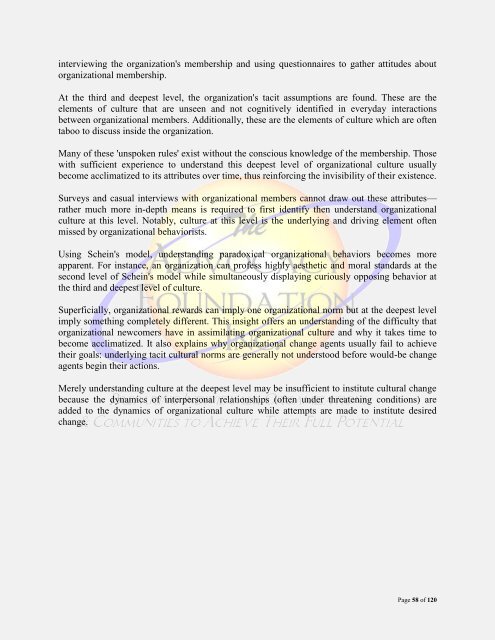Organizational Development - Vol. V, Part II
Organizational Development - Vol. V, Part II
Organizational Development - Vol. V, Part II
You also want an ePaper? Increase the reach of your titles
YUMPU automatically turns print PDFs into web optimized ePapers that Google loves.
interviewing the organization's membership and using questionnaires to gather attitudes about<br />
organizational membership.<br />
At the third and deepest level, the organization's tacit assumptions are found. These are the<br />
elements of culture that are unseen and not cognitively identified in everyday interactions<br />
between organizational members. Additionally, these are the elements of culture which are often<br />
taboo to discuss inside the organization.<br />
Many of these 'unspoken rules' exist without the conscious knowledge of the membership. Those<br />
with sufficient experience to understand this deepest level of organizational culture usually<br />
become acclimatized to its attributes over time, thus reinforcing the invisibility of their existence.<br />
Surveys and casual interviews with organizational members cannot draw out these attributes—<br />
rather much more in-depth means is required to first identify then understand organizational<br />
culture at this level. Notably, culture at this level is the underlying and driving element often<br />
missed by organizational behaviorists.<br />
Using Schein's model, understanding paradoxical organizational behaviors becomes more<br />
apparent. For instance, an organization can profess highly aesthetic and moral standards at the<br />
second level of Schein's model while simultaneously displaying curiously opposing behavior at<br />
the third and deepest level of culture.<br />
Superficially, organizational rewards can imply one organizational norm but at the deepest level<br />
imply something completely different. This insight offers an understanding of the difficulty that<br />
organizational newcomers have in assimilating organizational culture and why it takes time to<br />
become acclimatized. It also explains why organizational change agents usually fail to achieve<br />
their goals: underlying tacit cultural norms are generally not understood before would-be change<br />
agents begin their actions.<br />
Merely understanding culture at the deepest level may be insufficient to institute cultural change<br />
because the dynamics of interpersonal relationships (often under threatening conditions) are<br />
added to the dynamics of organizational culture while attempts are made to institute desired<br />
change.<br />
Page 58 of 120

















